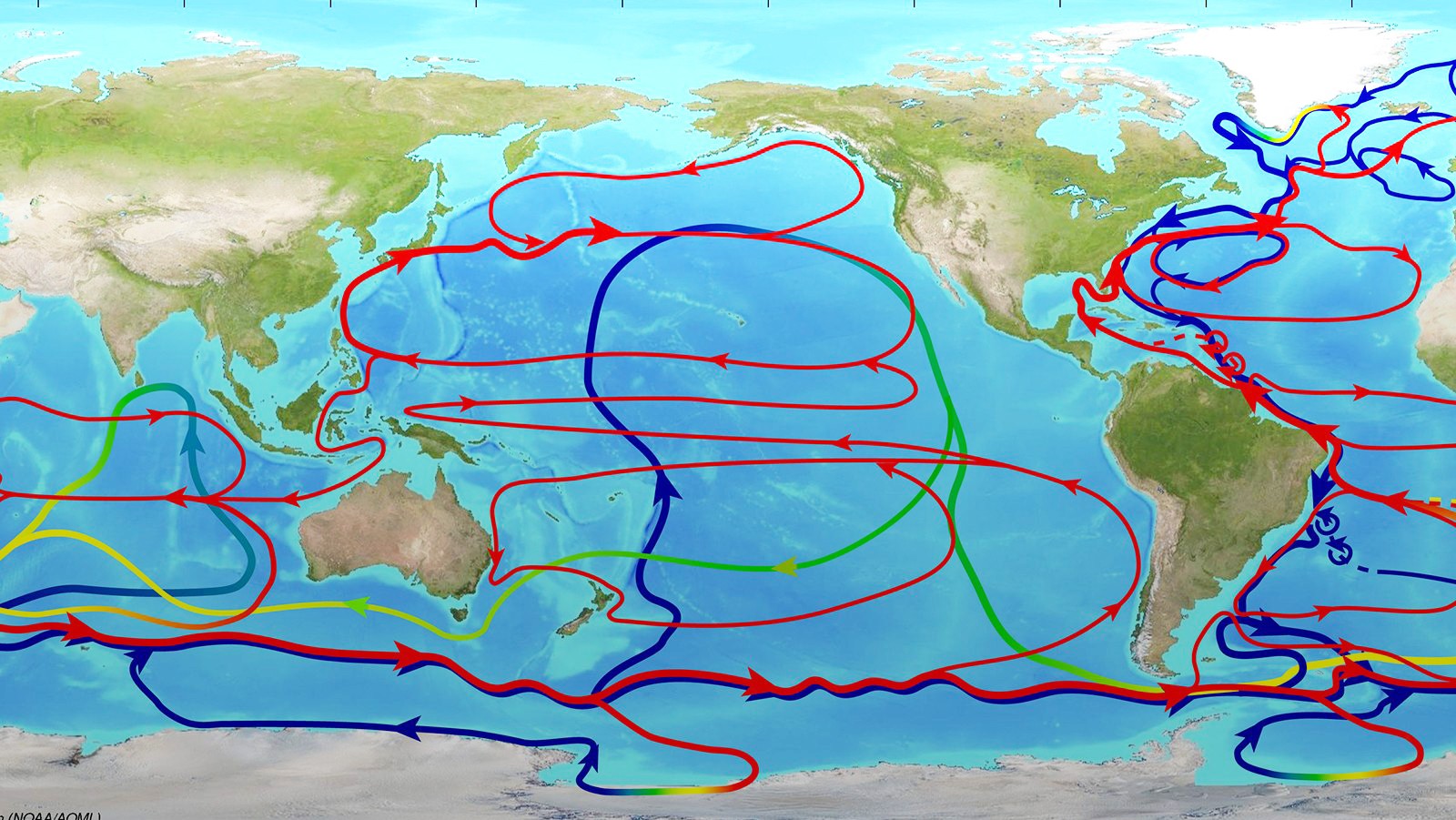Since the inception of the international South Atlantic Meridional Overturning Circulation (SAMOC) initiative in 2007, substantial advances have been made in observing and understanding the South Atlantic component of the Atlantic Meridional Overturning Circulation (AMOC). The goals of the SAMOC initiative are to monitor climatically relevant oceanic fluxes of mass, heat, and freshwater, provide observations to validate and improve numerical models and climate predictions, and understand the impacts of the SAMOC on climate and weather.
Thanks to the SAMOC initiative’s network of internationally coordinated observations, scientists have shown that the South Atlantic Ocean has warmed from its surface to the deep ocean, upper ocean salinity has increased, and that intermediate, deep water masses are freshening. Recent observational and modeling evidence also suggests that a reduction in the strength of the AMOC due to anthropogenic warming can be linked to surface warming and salinification in the South Atlantic. Monitoring these water mass changes and their causes is an ongoing priority for South Atlantic research.
Renellys Perez, Shenfu Dong, and Claudia Schmid, scientists at NOAA’s Atlantic Oceanographic and Meteorological Laboratory (AOML), contributed to an important recent international review article in Communications Earth and Environment led by Maria Paz Chidichimo (Argentine Scientific Research Council-CONICET and Hydrographic Service, Buenos Aires, Argentina). The NOAA team worked with co-authors from six countries (Argentina, Brazil, France, Germany, South Africa, and the United States) to synthesize insights gained into overturning flows, interocean exchanges, and water mass distributions and pathways in the South Atlantic from 15 years of SAMOC observations.
The global overturning circulation is a system of ocean currents that moves heat, freshwater, and carbon around the Earth. There is a surplus of heat in the tropics relative to the poles due to incoming solar radiation. The ocean, specifically the AMOC, plays a key role in redistributing this heat, as well as salt, dissolved oxygen, nutrients, and carbon throughout the global climate system. Variations in the strength of the AMOC have direct societal impacts on coastal sea levels, marine heat waves, extreme weather events, and shifts in regional weather and global climate.
The AMOC consists of two strong overturning cells, with an upper cell that transports warm, salty water from the subtropical South Atlantic Ocean across the equator. The water flows northward toward high latitudes in the North Atlantic, where it cools, sinks, and flows equatorward as cold deep water. This upper cell sits atop a cell of colder, denser water from the ice edge of Antarctica known as the abyssal cell. Together, these cells carry a maximum of 25% of the net global ocean and atmosphere energy (heat) transport.
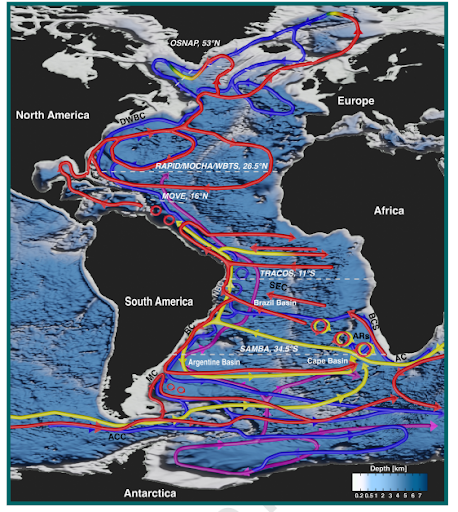
The South Atlantic Ocean plays a unique role in the global overturning circulation. It is the only ocean basin that transports heat towards the equator (instead of towards the poles), and it is the basin where the upper and abyssal cells are both prominent. Furthermore, it is the sole channel connecting the Atlantic water masses to the rest of the world’s oceans. The South Atlantic receives and transforms vast amounts of Pacific and Indian ocean waters before transferring them to the North Atlantic. In the deep ocean, the South Atlantic cold water masses (originally formed in the North Atlantic) are exported by the AMOC to other ocean basins. Theory and models suggest that the direction of the meridional freshwater transport by these water masses entering and exiting the South Atlantic may be key to the AMOC’s stability.
The South Atlantic observing system primarily consists of trans-basin and boundary current moored arrays and ship-based hydrographic observations (Conductivity, Temperature, and Depth, CTD; and eXpendable BathyThermograph, XBT). SAMOC researchers also use global satellites, Argo profiling floats, and surface drifting buoys, which provide key observations for AMOC studies.
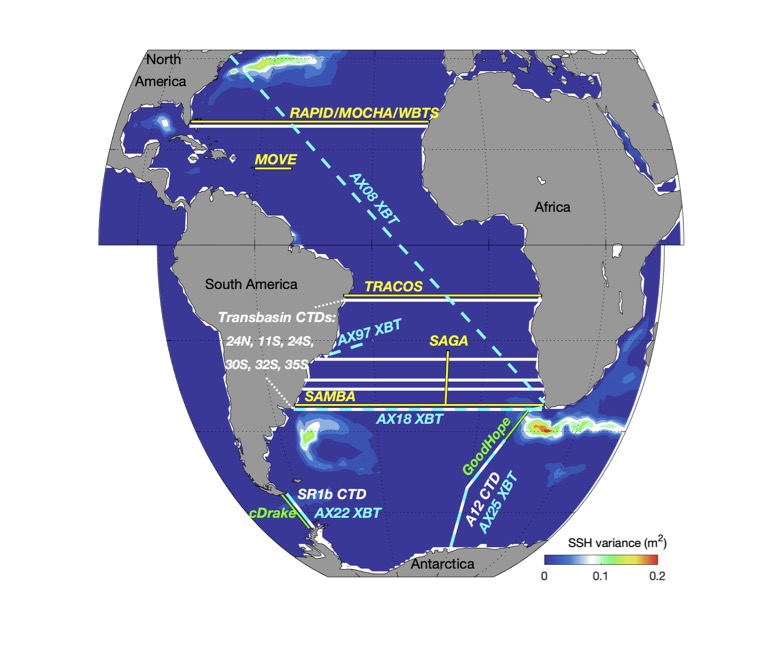
Hydrographic observations in the South Atlantic across the Drake Passage and south of South Africa from repeated ship-based CTD and XBT transects have been key in assessing the distribution, properties, and large-to-mesoscale (1000 km to 50 km) ocean dynamics in the basin, providing snapshots of the strength of the AMOC’s volume, heat, and freshwater transports. Hydrographic datasets in the region have increased dramatically over the past 20 years, due in large part to the expansion of the international Argo program in the 2000s. As of March 2022, there were more than 540 active Argo floats (including ~210 biogeochemical Argo floats and a dozen deep Argo floats) collecting water property profiles in the South Atlantic sector between the equator and 60°S. By analyzing hydrographic data that spans multiple decades, it is possible to assess how AMOC water mass properties and pathways vary over time. Hydrographic data have also been combined with sea level and wind observations from satellites to provide important insights into the multi-decadal changes in the AMOC across the South Atlantic.
Additionally, the expansion of the SAMOC observational network over the past 10–15 years, particularly along the SAMBA line at 34.5°S and the TRACOS line at 11°S, have provided key information about the structure and day-to-day variability of the AMOC volume transports at these two latitudes, as well as the corresponding structure and variability of the western and eastern boundary flows in the South Atlantic. At 34.5°S, daily estimates of the meridional heat transport by the AMOC and volume transport by the abyssal cell have also been made using mooring data. Cruises in support of the 34.5°S and 11°S moored arrays have greatly increased the number of full-depth hydrographic profiles available in the region. At the same time, observing systems at the gateway of the Pacific and Indian basins monitor interocean exchange processes that impact the AMOC’s transports at 34.5°S and water mass properties in the South Atlantic.
Over the past two decades, the SAMOC international scientific community has made numerous advances in the study of the AMOC due to the growth of long-term observing programs in the Atlantic basin and newly developed observational analysis techniques.
Inclusive Science in the South Atlantic
In addition to the advances made in understanding the variability of the SAMOC, major strides have been made toward developing a balanced and inclusive approach to science as part of the SAMOC initiative. As documented in a recent comment article in Communications Earth and Environment by Renellys Perez (AOML), Silvia Garzoli (AOML emeritus), Rebecca Hummels (GEOMAR), and Isabelle Ansorge (University of Cape Town), the SAMOC community has a culture of collaboration that has been fostered throughout the years via joint SAMOC workshops, fieldwork, and science sessions arranged at large scientific conferences.
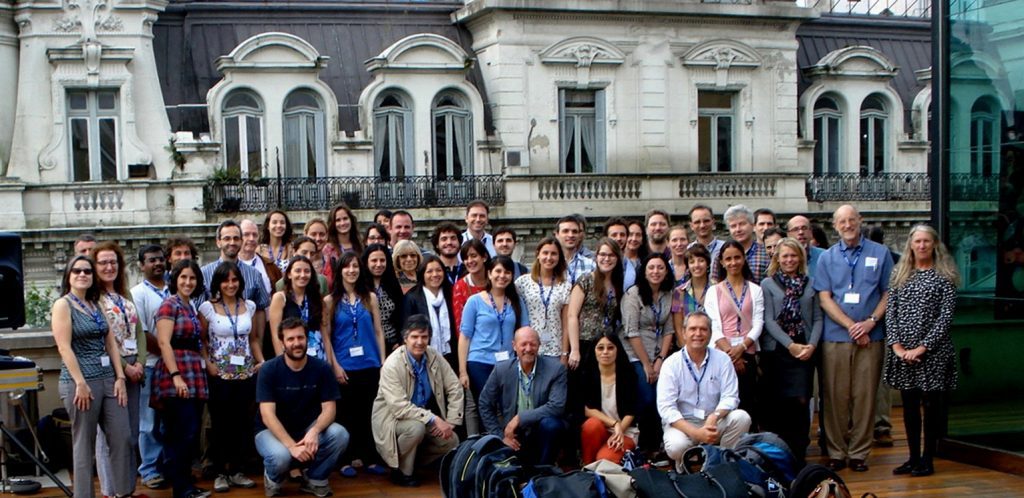
The first SAMOC executive committee was created with four scientists (Alberto Piola, Edmo Campos, Sabrina Speich, and Silvia Garzoli) from Argentina, Brazil, France, and the United States providing equal participation from the northern and southern hemispheres and an equal representation of male and female scientists. As the initiative expanded over the years, the executive committee grew to include mid-career and senior scientists from South Africa, Germany, and Spain, thereby expanding membership to researchers from all four continents bounding the Atlantic Ocean.
In early 2022, a voluntary census of the SAMOC community was conducted in the form of an online survey, which resulted in 33 responses. Participants were given the option to opt-out of answering demographics questions, or use their own wording for their responses. Some of the results can be seen in the figure below.
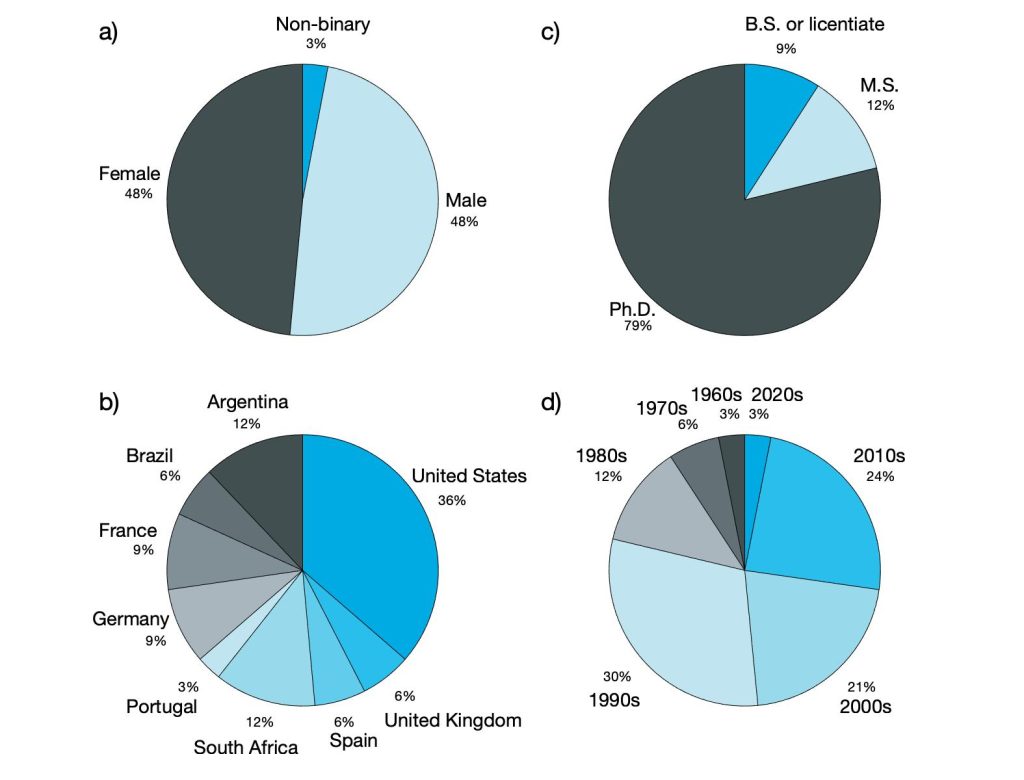
From the survey, the authors learned that 78.1% of the respondents view the SAMOC community to be “very inclusive” with regards to gender, and 54.8% view SAMOC as “very inclusive” with regards to race or ethnicity. Today the SAMOC initiative encompasses a range of distinct observing programs led by researchers from more than nine countries, spanning a wide range of career stages.
In addition to creating an inclusive and diverse environment, the SAMOC initiative community aims to build capacity in marine sciences. An example of this is the creation of Floating Universities, specifically South Africa’s annual SEAmester cruise, which is a spin-off from SAMOC cruises. These cruises introduce marine science as an applied and cross-disciplinary field to students from across the sub-Saharan continent by combining theoretical classroom learning with the application of this knowledge through hands-on research.
What began as a grassroots effort to study the South Atlantic Ocean and its impact on climate has become a platform for the empowerment of women and international scientists. Although there is still progress to be made, the SAMOC initiative has created a unique space where scientists spanning several generations from different backgrounds and countries of origin work together toward achieving a shared research mission.
These articles are part of a special collection in Communications Earth and Environment focused on the South Atlantic Ocean.
